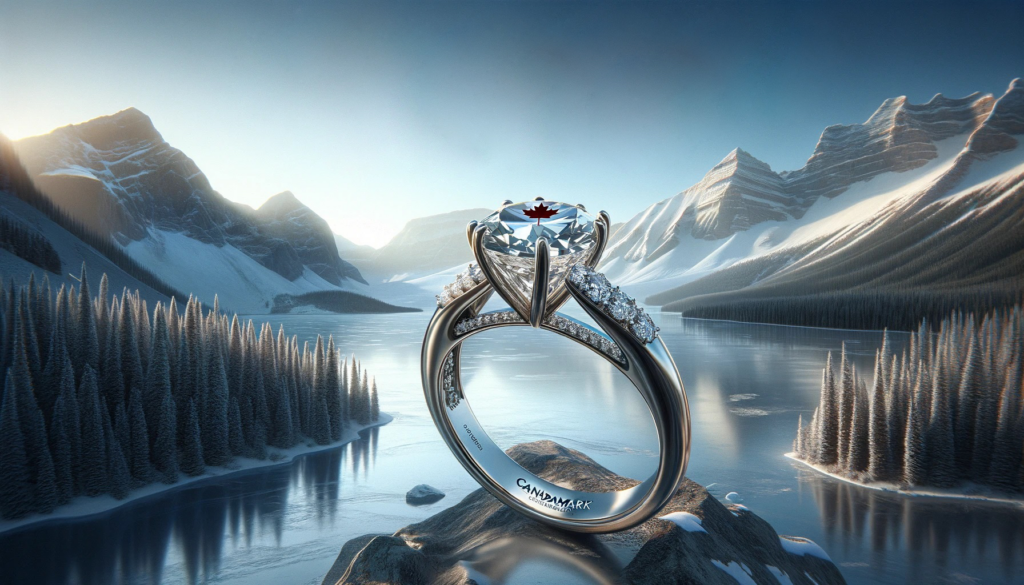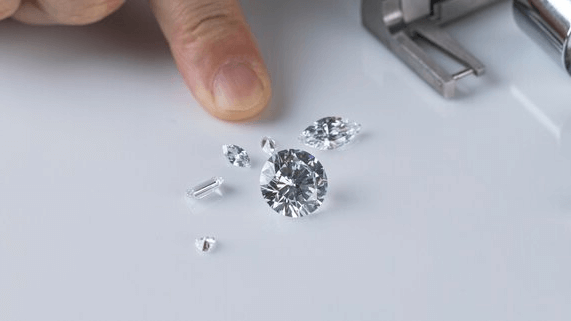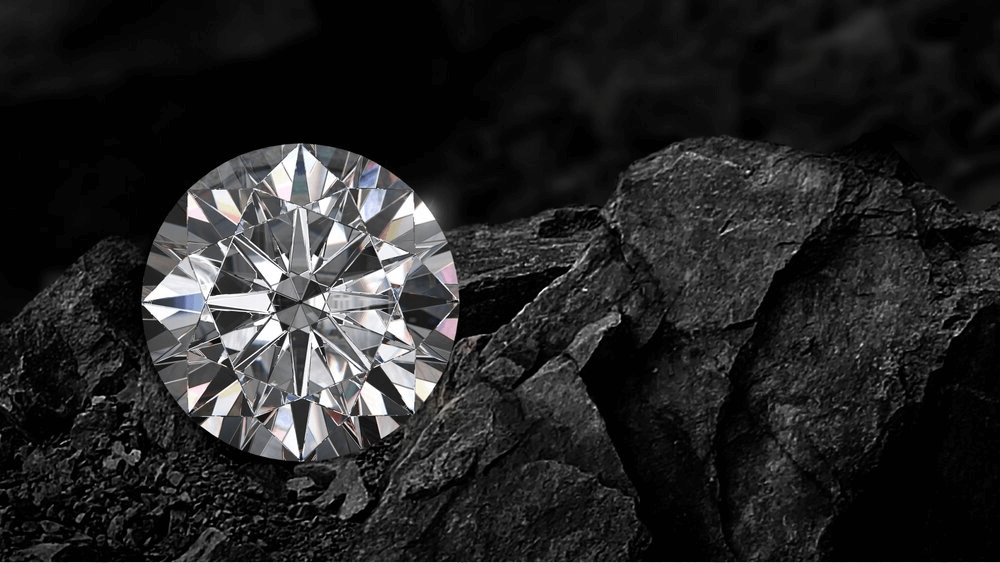The Magic Behind Canadian Diamond Mines & CanadaMark

By Gary A.

Edited by Olivia H.
Published Dec 24, 2021
Edited on Mar 31, 2025
With a reputation for ethical sourcing and unmatched quality, Canadian diamonds and CanadaMark have become the go-to choice for those seeking a sparkling gemstone that reflects both beauty and responsibility.

- 7 Quick Tips for Canadian Diamond Engagement Ring
- Introduction
- The Rise of a New Gem Powerhouse
- A Brief History of Canadian Diamonds
- The Ethical Pillars of Canadian Diamond Mining
- Tracing the Journey from Mine to Market
- Our Expert Take: The Enduring Appeal of Canadian Diamonds
- 10 FAQs
Before we dive deeper into the specifics, here are some practical tips to help guide your decision-making process:
7 Quick Tips for Canadian Diamond Engagement Ring
When purchasing a diamond engagement ring, especially with a focus on Canadian diamonds, there are several critical factors to consider. These tips will guide you in making an informed decision, ensuring that the diamond you choose is not only beautiful but also aligns with ethical and quality standards.
- Tip 1:Verify the Canadamark Certification: Canadamark certification is a key indicator of authenticity for Canadian diamonds. Ensure the diamond comes with a certificate verifying its Canadian origin and adherence to ethical mining practices. Check the unique serial number inscribed on the diamond, which should match the certificate.
- Tip 2:Understand the Diamond’s Traceability: Canadian diamonds are known for their traceable journey from mine to market. Inquire about the specific mine of origin and the path the diamond has taken. This information not only ensures ethical sourcing but can also add sentimental value to your ring.
- Tip 3:Assess the Quality Attributes: Focus on the 4Cs (Cut, Color, Clarity, Carat), which are crucial in evaluating a diamond’s quality. Canadian diamonds are often prized for their low fluorescence and high clarity. Compare these attributes against other diamonds to understand their impact on appearance and price.
- Tip 4:Evaluate Environmental Impact: Investigate the environmental practices of the Canadian mine where the diamond was sourced. Look for mines that prioritize sustainability and minimize ecological impact. This consideration is essential for environmentally conscious buyers.
- Tip 5:Consider the Price Premium: Be aware that Canadian diamonds typically command a higher price due to their ethical sourcing. Compare prices with non-Canadian diamonds to understand the premium you are paying for ethical assurance. Decide if the ethical aspects align with your values and budget.
- Tip 6:Research Market Trends: Stay informed about the latest trends in the Canadian diamond industry. Understanding market dynamics can help in negotiating a fair price and choosing a timeless design. This knowledge is particularly beneficial if you’re looking for an investment piece.
- Tip 7:Check for Customization Options: Explore customization options for your engagement ring, especially if you’re choosing a Canadian diamond. Some jewelers offer unique settings and designs that enhance the natural beauty of Canadian diamonds. Customization can make your engagement ring more personal and meaningful.
Now that you’ve got these practical tips, use Jeweler AI below to find the perfect engagement ring that suits your style and budget:
Introduction
Canada boasts some of the wildest and most punishing environments in the world – but also some of the most beautiful. From frozen lakes and snow-covered mountains to acres of forest, prairies, and wetland, it offers a glimpse of an ancient world – and its creations.
True, when we think of the diamond world, we think of Botswana’s sprawling Orapa mine, or of the hard, permafrost landscape of Yakutia in the Russian Far East. For many of us, it’s easy to think of the world’s diamond resources as remote from us – parts of landscapes that would be, in some way or another, unfamiliar. The jewelry store feels a world away from the images we see of colossal mines tunnelling down (seemingly) into the center of the earth, after all.
In many cases, this is true. Botswana and Russia represent two of the largest producers of rough diamond, and countless shoppers who reside on the other side of the world carry small pieces of those unique landscapes on their fingers, wrists, and necks.
The Rise of a New Gem Powerhouse
These days, diamond mining in Canada has grown into a major industry, and diamonds represent a particularly popular choice among shoppers who want to ensure that their stone has been mined and cut according to a high standard for ethics and sustainability.
As in the case of any diamond on the planet today, Canada’s diamonds rely on the strength and fortitude of those who mine them. Brought into some of the most hostile climactic conditions imaginable, where snow and ice and darkness oversee a barely habitable landscape, these diamonds represent a feat of human ingenuity and modern mining methods.
A Brief History of Canadian Diamonds
Recent years have seen Canada diamonds undergo a meteoric rise in terms of popularity, but the general population only received confirmation of their existence a little over thirty years ago. Their existence is, however, thought to have been known by indigenous groups.
While preliminary geological investigations of the area De Beers had sparked that initial wave of interest in the country’s diamond mining potential (signs of volcanic deposits that so often accompany kimberlite, a rock often interspersed with rough diamond) it wasn’t until 1989 when the first kimberlite pipe was found by two geologists: Chuck Fipke and Stewart Blusson.
A kimberlite pipe is a little like an inverted cone, with the narrowest point buried deep under the earth’s surface. From these pipes, kimberlite ore can be extracted and, from that, rough diamond.
More kimberlite pipes were found and, accordingly, more and more mines were created close to the turn of the century. Some of these mines were tucked away in remote corners of the Canadian wilderness, and became accessible only by air or ice road, open for just a fraction of each year.
Strict Labor Laws and Environmental Protections
From the moment the diamond industry’s interest turned in Canada’s direction, the country has stipulated some of the most stringent rules in the world for the ethical treatment of indigenous groups living in the area surrounding these mines, and of the environment itself. From local flora and fauna to entire communities, the emphasis was placed squarely on sustainable and ethical practices from the very beginning.
This is one possible reason why so many consumers look specifically to Canadian diamonds. As a relative newcomer, and one that did not go through the same political struggles that some of the world’s prominent producers went through in the past, it feels like a ‘safer’ choice for ensuring an ethical choice.
The Ethical Pillars of Canadian Diamond Mining
Canada’s pre-existing labor laws provided a strong footing for the fledgling diamond industry back in the 1990s and early 2000s – not to mention their dedication to preserving the country’s unique and, at times, vulnerable landscapes, and cultural groups.
The introduction of diamond mining into Canada was not without its ethical quandaries. For instance, the caribou population – something indigenous groups rely on quite significantly for meat – is thought to have been impacted severely by the production of mining-related dust, since it disrupts the balance of local flora that the caribou feeds on. Similar impacts have been felt by other species that are important for Canada’s bionetwork, and aquatic life, but ongoing work is being done to ensure greater protective measures for the environment.
Canada is, in other words, tackling many of the same issues felt in any other country with a significant diamond output: contamination, displacement, environmental changes and declining animal populations.
Nevertheless, the country has been working to counteract those impacts since commercial mining began – and, thankfully, the relative newness of Canada’s diamond industry meant that it had better technologies and information at its disposal to safeguard from the very beginning.

The Uniqueness of Canadian Diamonds
In 2019, Canada accounted for around 12.5% of the world’s production by value, making it the third largest producer behind Botswana (2nd) and Russia (1st), and a major source of economic growth over the past fifteen to twenty years.
Much of its production is centered around the Northwest Territories, with its largest mine, Daivik, employing around 1,000 workers and covering approximately 7km². Ongoing work is being done to create opportunities for indigenous peoples to benefit from the economical growth brought by diamonds.
Tracing the Journey from Mine to Market
The popularity of Canadian diamonds stems almost entirely from their traceability, and the robust rules surrounding their production. While a number of other countries around the world have amended their approach to diamond mining over the years, Canada started off differently and, for that reason, proves popular among consumers.
For this reason, Canadian diamonds are often marketed as ‘Canadian diamonds’ – and sold at a slightly higher price than diamonds sourced from other parts of the world. While reputable sellers will always be aware of their diamonds’ origins, it’s less common for them to market them as specifically Namibian diamonds or Botswanan diamonds.
Of course, there are plenty of ethical diamond sources outside of Canada, but the unique way in which Canadian diamond mining came into being means that it represents a pretty obvious choice for many consumers
Famous Canadian Diamonds
In 2020, a flawless 102 carat diamond mined from a Canadian mine – and originally 271 carats when rough – was sold at an international auction for an incredible $15.7 million. While it’s not the largest diamond to be found in North America, its flawlessness meant that it gripped headlines.
In general, Canadian diamonds are known for their low fluorescence and good clarity – although, as with any other of the world’s diamond sources, there will always be a lot of variation between any rough diamond brought to the earth’s surface.
A Cut Above? Quality and Characteristics
The only difference between a Canadian mined diamond and a diamond mined elsewhere is the fact of its origins – the measures in place to protect the workers and the environment involved along the way.
Sure, Canadian diamonds might be known for their low fluorescence, but a Botswanan diamond with the same level of fluorescence (and cut, color, clarity, and carat weight) won’t be distinguishable from the Canadian diamond without an origin report.
Are Canadian Diamonds More Ethical?
Not necessarily. While Canadian diamonds are subject to some high standards for protecting the environment and those living and working in the area, plenty of other countries responsible for producing diamonds also impose high standards on their industry leaders.
Remember that it isn’t a case of Canada’s approach to diamond mining, and then the rest of the world. Every country takes its own approach to diamond production, which means that Canadian diamonds are not the only ethical choice.
Canadian diamond mining still causes some concerns for Canada’s environment. These issues are, of course, being addressed very rapidly to ensure that the least impact possible is made on the planet, much like it is in a number of other countries.
Canadamark
Any shopper who makes the decision to home in on Canadian diamonds will inevitably run up against the name ‘Canadamark’ sooner or later. As more and more shoppers become aware of the long journey that diamonds make from the earth to the jewelry store, brands that push for greater transparency are growing increasingly popular.
We’ve already touched on the fact that the popularity of Canadian diamonds largely stems from the fact that shoppers feel that they offer more guarantees of fairness, safety, and environmental concern than they do when diamonds come from countries still, to some extent, tarnished by the legacy of blood diamonds. While the overwhelming majority of African diamond-producing countries have totally transformed their diamond industries (and others, like Botswana, never experienced that conflict in the first place), Canadian diamonds still have a certain edge for shoppers who haven’t looked deeper into the subject.
This is where a name like Canadamark comes into the picture. They are an authority in the diamond industry – a familiar name that tells shoppers exactly where their diamond came from, and that its journey was overseen by someone they can trust…
What Does Canadamark Mean?
A Canadamark diamond has been mined from one of a small number of Canadian diamond mines overseen by the Arctic Diamond Mining Company.
It was previously known as Dominion Diamond Corporation, until it was eventually acquired and renamed by The Washington Companies. The Washington Companies have a big stake in the diamond world, having once owned Harry Winston, Inc. – a luxury retailer on a par with Cartier, Van Cleef & Arpels, and Tiffany & Co. While ownership passed to another buyer in 2013, The Washington Companies’ involvement in luxury gemstones continued.
The label Canadamark was first introduced in the early 2000s, when consumers grew significantly more aware of the dubious histories behind many diamonds produced in countries experiencing civil unrest. Of course, this is also the time when the Kimberley Process was first established – and, ultimately, when the diamond world started to augment its efforts against blood/conflict diamonds.
So, what does it mean for a diamond to be ‘Canadamark’? It means that these diamonds are traceable straight back to the source. They are mined from one of a limited number of locations in Canada – locations that are subject to Arctic Diamond Mining Company’s own standards and regulations for its workers and the environment.
The diamonds are inscribed with Canadamark’s branding (and a unique serial number) along the girdle to assure buyers that they are genuine Canadamark diamonds – a big selling point for anyone under the impression that ethical diamonds are in the minority.
Are Canadamark Diamonds More Expensive?
Canadian diamonds in general are more expensive than diamonds imported from further afield.
In fact, diamonds sourced from Canada can be between 10-20% more expensive, simply because shoppers who have not done their research consider it the ‘safest bet’ to avoid unfair or harmful working conditions. It’s certainly understandable why they feel this way, but research is easy these days – easier than paying above the odds.
That’s not to say that Canadamark diamonds aren’t what Arctic Diamond Mining Company say they are. Canadian mines are subject to some incredibly high standards – but they’re not alone in that. Canadamark is backed by an effective marketing strategy, and, for that reason, it gets to charge shoppers a premium.
Where Can You Buy Canadamark Diamonds?
Canadamark does not have any showrooms or stores of its own; instead, a number of retailers stock Canadamark diamonds.
In 2017, James Allen became Canadamark’s exclusive online retailer but, since then, a number of other big name retailers have started to stock them too. Stuller, for instance, stocks Canadamark diamonds.
There are, however, different ways for retailers to convey a philosophy of fairness and environmental concern to their customers. As one example, Tiffany & Co. clearly state the origins of their diamonds – a practice they began back in 2019, making them the first luxury jeweler to specific the origin of any diamond above 0.18 carats in weight that they sold from any of their stores.
Countless small-scale jewelers up and down the country – and, for that matter, around the world – have been offering a similar level of traceability to customers, and with the global diamond industry now stronger than ever against crime and exploitation, finding an ethical diamond is easier than ever before.

Are Canadian Diamonds Cheaper?
No, Canadian diamonds are generally more expensive than diamonds sourced from other parts of the world.
It can be tricky to draw up direct comparisons, however, as you would need to find two diamonds with the exact same characteristics – both graded by the same lab (preferably the GIA, or you can’t depend on that lab’s ability to remain consistent).
Our Expert Take: The Enduring Appeal of Canadian Diamonds
There is a very good reason why Canadian diamonds are so highly regarded on the global market: the country’s entire industry has been built according to rigid rules and codes of conduct that were specifically written to preserve its natural landscapes – the very landscapes that gave rise to the country’s diamonds in the first place – and the people living within them.
It’s commendable, and a great way of ensuring that the diamond you buy has not left a negative mark on the world since the moment it was brought to the surface.
As consumers, however, it is important to remember that Canada’s strengths do not represent another country’s weaknesses, and that Canadian diamonds do not represent the only moral choice.
In countries all around the world, diamonds are being mined, and environments are being cared for. True, there is more work to be done to ensure that humans, animals, and plants are able to thrive, unhindered by diamond mining, but the same can be said to some extent for Canada.
At WillYou.com, we are passionate about ensuring that shoppers can find diamond experts who are as committed to sourcing their diamonds ethically – whether from Canada, Botswana, Russia, Angola or anywhere else – as they are. You can browse our diamonds knowing that every precaution has been taken to source them ethically.
10 FAQs
- Q: What makes Canadian diamonds unique?
- Answer: Canadian diamonds are known for their ethical sourcing, high quality, and traceability. They come from mines that adhere to strict environmental and labor standards, making them a popular choice for consumers seeking ethically sourced jewelry.
- Q: How can I verify the authenticity of a Canadian diamond?
- Answer: Authentic Canadian diamonds come with a Canadamark certification, which includes a unique serial number inscribed on the diamond. This number and the accompanying certificate confirm the diamond’s Canadian origin and ethical sourcing.
- Q: Are Canadian diamonds more expensive than others?
- Answer: Yes, Canadian diamonds often command a premium due to their ethical mining practices, traceability, and high-quality standards. This premium is for the assurance of ethical and sustainable sourcing.
- Q: Can I trace the exact mine a Canadian diamond came from?
- Answer: Yes, one of the key features of Canadian diamonds is their traceability. You can trace back to the specific mine in Canada where the diamond was sourced, which is often documented in the certification process.
- Q: Do Canadian diamonds differ in quality compared to others?
- Answer: Canadian diamonds are known for their high quality, particularly in terms of clarity and color. However, like all diamonds, they are graded on the standard 4Cs (Cut, Color, Clarity, Carat), so quality can vary within those parameters.
- Q: What is the environmental impact of Canadian diamond mining?
- Answer: Canadian diamond mines are subject to Canada’s strict environmental laws. While mining does impact the environment, Canadian mines strive to minimize this impact and rehabilitate the land post-mining.
- Q: How does the Canadamark program ensure ethical practices?
- Answer: The Canadamark program audits the journey of the diamond from the mine to the final product, ensuring that each step adheres to ethical labor practices, environmental standards, and responsible sourcing.
- Q: Are all diamonds mined in Canada considered ethical?
- Answer: While Canadian diamonds are generally considered ethical due to stringent regulations, it’s important to look for specific certifications like Canadamark to ensure the diamond you’re purchasing meets the highest ethical standards.
- Q: Can Canadian diamonds be customized in engagement rings?
- Answer: Yes, Canadian diamonds can be customized in various engagement ring settings. Many jewelers offer unique designs that highlight the natural beauty of these ethically sourced diamonds.
- Q:. Is the Canadamark inscription visible to the naked eye?
- Answer: No, the Canadamark inscription is a microscopic engraving on the diamond’s girdle. It is not visible to the naked eye but can be seen under magnification.
Discover the brilliance of Canadian diamonds with Jeweler AI – where ethical beauty meets exquisite craftsmanship.
FOLLOW-UP GUIDE SERIES








